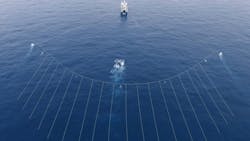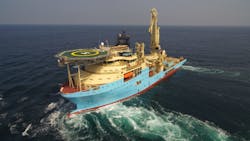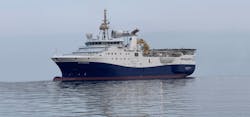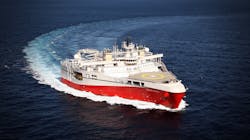Editor's note: This article first appeared in the May-June issue of Offshore magazine. Click here to view the full issue.
By Ariana Hurtado, Editor and Director of Special Reports
The future is looking bright for seismic service providers this year.
Recent analysis by Esgian revealed that seismic campaigns and capex budgets are all up, with major seismic player highlights that include:
- CGG: fourth-quarter 2022 delivered higher-than-anticipated multiclient data and equipment sales;
- PGS: 2022 multiclient late sales second highest on record; and
- TGS: highest fourth-quarter 2022 late sales since 2014.
Offshore recently chatted with analysts from Rystad Energy and S&P Global about the recovering seismic survey market to gauge their thoughts on the current trends and outlook for the remainder of the year.
"With increased exploration activity, demand for seismic services is expected to grow by an additional 14%, or $1.1 billion, and total almost $9.3 billion in 2023," said Binny Bagga, vice president of supply chain analysis with Rystad Energy. "Key offshore regions such as the Gulf of Mexico [GoM] and the North Sea are expected to remain core to the seismic market, with strong growth expected in Norway. The surge in oil and gas prices in the past year following Russia’s invasion of Ukraine has led to an increased appetite for offshore exploration spending among majors and national oil companies alike. Mature basins are set to take the lion’s share of exploration capital expenditure, while 20% of the year’s total is set to go on frontier basins, a hike of more than 50% from 2022."
Tracking the marine seismic market and its vessels, Beth Sinclair, an analyst with Petrodata SeismicBase by S&P Global, added, "The consensus within the industry is that 2023 and beyond will see the seismic market go from strength to strength as the upturn is deemed to be finally in full swing. There is real optimism. Continued energy security concerns and improved profits have seen oil and gas companies increase their E&P spending, which in turn has seen the revenues of seismic firms rise."
Vessel updates
In the final quarter of 2022, PGS reported that vessel day rates had risen by 35% year-on-year and has since said it expects this to continue, though it is unlikely to replicate the rate increase experienced between 2021 and 2022, according to Sinclair.
"The uptick in multiclient late sales and the success in obtaining full prefunding for multiclient sweeps off Brazil, West Africa and Southeast Asia demonstrates the current appetite for exploration once again, and seismic companies will be happy to be bolstering their coffers. Especially the vessel owners," she said. "The streamers in the global fleet are generally getting quite old, and to replace a full spread costs approximately $50 million, as quoted by PGS."
Meanwhile, companies are reactivating vessels, such as Shearwater's SW Mikkelsen and SW Gallian last year and PGS’ Ramform Victory this year, which "exemplifies the confidence companies have in the market going forward," Sinclair added. "It is a pricy business to take vessels out of cold stack."
Collaborations, M&A
"The marketplace is certainly changing, however, with collaboration and amalgamation an ongoing trend," Sinclair explained. "Companies strike vessel time agreements (e.g., CGG with Shearwater GeoServices; WesternGeco with Shearwater GeoServices; TGS with COSL) while acquisitions shrink the market. TGS’ most recent acquisition of Magseis Fairfield has placed it at the forefront of the OBN [ocean-bottom node] sector. Meanwhile, SeaBird is calling for more mergers, believing that its source/2D vessels would be the perfect addition to an OBN company."
Sinclair said OBN is on the "up and up" and that crews are booked throughout 2023 and onward. For example, PXGEO’s OBN crew has work offshore Brazil until August 2024. A crew formerly operated by Magseis Fairfield (now TGS) has work in Guyana until the end of the year, she said, while a second TGS crew has contracts in the US GoM stretching beyond that.
In addition, TGS signed a collaboration agreement with SLB in March, under which the two companies will gain access to each other’s US GoM data for sparse OBN acquisition and processing. The combined database, covering all prospective areas of the US GoM, will allow the companies to jointly pursue multi-year acquisition campaigns over producing and exploration acreage.
"Shearwater GeoServices (with its newly activated source vessels mentioned above) will also remain in the US Gulf of Mexico for the foreseeable future, while SW Tasman is being converted into the industry’s first dual ROV, source and streamer multi-purpose vessel," Sinclair said. "Meanwhile, SW Vespucci has Norwegian OBN work to keep it busy throughout the summer season, TGS/Magseis Fairfield is mobilizing a crew to work in Norwegian and UK waters in the coming months, and SAExploration has been contracted by TGS to gather multiclient data around Carbon Transition’s Utsira survey off Norway."
Market outlook
"The strong market outlook for 2023 is good news for the seismic companies after the promising developments we have seen last year," Bagga said. "Preliminary revenue reports from both TGS and PGS for the first quarter of this year as well as numerous recent contract awards point to continued growing demand for seismic services. Multiple contracts that will support the suppliers’ growth this year have been awarded in the past few months."
The following sampling summarizes some of the latest contract awards around the world.
South America
In April TGS announced the commencement of the second stage of a Peninsular Malaysia multiclient 3D reprocessing project covering 20,347 sq km from 32 3D seismic studies in collaboration with DownUnder GeoSolutions (DUG). Combined with the 16,957-square-kilometer first stage of the project, it will be one of the largest of its kind in Asia to date, Bragga added.
Other major seismic contractors such as Shearwater have also announced several contract awards in recent months, including two contracts awarded to Shearwater by Petrobras for 4D seismic surveys at the Jubarte and Tartatuga Verde fields in the Campos Basin off Brazil.
Equinor and partner YPF gained environmental approvals in April to acquire 3D seismic across three blocks offshore Argentina, with Shell and TotalEnergies, along with partners bp and Qatar Energy, also set to acquire 3D seismic on their Argentinian acreage during 2023/2024.
That same month, PGS released the first data from its new Pacific MegaProject covering prospective areas across much of Colombia's offshore Tumaco and San Juan basins. The company has reprocessed all available data in the target area to produce a single unified and rejuvenated MegaProject dataset. This is said to provide new insights into potential petroleum system elements and possible hydrocarbon-bearing traps.
Back in March, a consortium of CGG, TGS and BGP completed Phase IV of their deepwater 3D seismic survey offshore Suriname. The 1,800 sq km covered was the final part of a program to acquire 14,500 sq km survey of new 3D data in deep and shallow water in the Guyana-Suriname Basin, with more than 6,400 sq km of existing data reprocessed.
The Petrobras-led Sépia consortium contracted PXGEO in March to acquire a 3D OBN survey in the Santos Basin offshore Brazil. The program, in water depths of up to 2,300 m, will take about four months to complete. It will be PXGEO’s fourth acquisition project for Petrobras since mid-2021.
Europe
In April GEOxyz’s Geo Ocean III vessel started a geophysical survey for Hartshead Resources over the Anning and Somerville gas fields and planned inter-field pipeline locations in the UK southern North Sea. The 77-m-long DP2 vessel is equipped with cone penetration testing and vibrocoring equipment.
Additionally, in February PGS completed 2D seismic surveys over the West and southwest areas offshore Crete, Greece, for licensees Exxon Mobil and Helleniq Energy. Hellenic Hydrocarbons and Energy Resources Management Co. (HEREMA), the authority that manages the concession rights on behalf of the Greek State, said a total of 12,278 line km were collected, far above the minimum contractual obligation of 6,500 km for the two blocks combined.
Late last year, CGG formed an agreement with Carbon Transition subsidiary Axxis Multi Client to reprocess the Utsira OBN seismic survey in the Norwegian North Sea. The 2,000-sq-km Utsira survey, which is due to be completed in 2024, is claimed to be the largest ultra-high-resolution OBN survey in the North Sea. For the reprocessing, CGG will employ OBN processing and imaging technology including time-lag full-waveform inversion.
Gulf of Mexico
In February TGS and SLB started acquisition of the Engagement III ultra-long offset OBN survey in the Green Canyon region in the US GoM. The 111 OCS Block survey was expected to be completed in April and deliver imaging uplifts through full-waveform inversion velocity model building, using ultra-long offsets. SLB will perform imaging with final results expected in mid-2024. Engagement III, the fifth multiclient ultra-long offset OBN acquisition exercise in the GoM, will extend the data coverage south from prior phases.
That same month, TGS inked a letter of agreement to shoot a proprietary 4D OBN survey over the Walker Ridge canyon in the US GoM. The company expects to mobilize for the 100-day campaign this summer.
Africa
In addition, a 3D survey over PEL 87 and the surrounding area in the Orange Basin offshore Namibia had reached progress of being more than 50% complete as of late April, according to Sintana Energy. The survey will cover a total area of 6,872 sq km. Initial processed results should be available by the end of August. Woodside Energy reportedly covered the costs of the $35 million 3D seismic survey over an area of at least 5,000 sq km.
Asia-Pacific
Korea National Oil Corp. has commissioned Shearwater to acquire a 3D streamer survey offshore South Korea. The 1,200-sq-km survey will be the company’s third project for the state-owned oil and gas corporation.
At the beginning of the year, TGS, SLB and Petrobangla conducted a new multiphase 2D seismic program offshore Bangladesh. The initial phase involved acquiring a minimum of about 11,000 line km of HR broadband seismic data, designed to improve understanding of the prospective Bengal Fan. According to TGS CEO Kristian Johansen, this is one of the world’s most-extensive remaining unexplored frontier basin.
The energy transition
"The ongoing energy transition is expected to create alternative revenues streams for seismic players that have diversified their businesses by venturing into the carbon storage, geothermal, offshore wind and deepsea mining sectors," Bagga said.
For example, Fugro plans to perform offshore geotechnical site investigations for the Star of the South wind development off the Gippsland coast in southeast Australia.
As another example, TerraSond and Benthic, both in Acteon’s Data and Robotics division, will perform geophysical and geotechnical survey work for two planned floating wind farms northeast of Aberdeen. The Ocean Fortune vessel, under long-term charter to TerraSond, will acquire the geophysical survey with support from Acteon in Aberdeenshire and UTEC’s data center in Livingston.
Additionally, Thistle Wind Partners recently initiated seabed surveys for its two ScotWind projects: the 1-GW Ayre floating offshore wind farm offshore Scotland and the 1-GW Bowdun fixed foundation wind farm offshore Aberdeenshire in the North Sea. G-tec is leading the first phase, geophysical surveys of the seabed at both sites in leasing zones NE2 and E3, which are due to continue through October. The survey vessel will cover an area of almost 400 sq km. G-tec specialists will process the data, applying the results to ground modelling studies from October onward, with metocean surveys starting around the same time.
"The current climate is the perfect storm for seismic firms," Sinclair concluded. "The continued need for traditional oil and gas exploration, paired with the ongoing energy transition process, puts the seismic industry in an enviable position. Frontier exploration is once again in favor, while the need for specialized seismic over potential CCS and wind farm sites means seismic companies can be at the forefront of new exploration and data processing innovation."
About the Author
Ariana Hurtado
Editor-in-Chief
With more than a decade of copy editing, project management and journalism experience, Ariana Hurtado is a seasoned managing editor born and raised in the energy capital of the world—Houston, Texas. She currently serves as editor-in-chief of Offshore, overseeing the editorial team, its content and the brand's growth from a digital perspective.
Utilizing her editorial expertise, she manages digital media for the Offshore team. She also helps create and oversee new special industry reports and revolutionizes existing supplements, while also contributing content to Offshore's magazine, newsletters and website as a copy editor and writer.
Prior to her current role, she served as Offshore's editor and director of special reports from April 2022 to December 2024. Before joining Offshore, she served as senior managing editor of publications with Hart Energy. Prior to her nearly nine years with Hart, she worked on the copy desk as a news editor at the Houston Chronicle.
She graduated magna cum laude with a bachelor's degree in journalism from the University of Houston.





